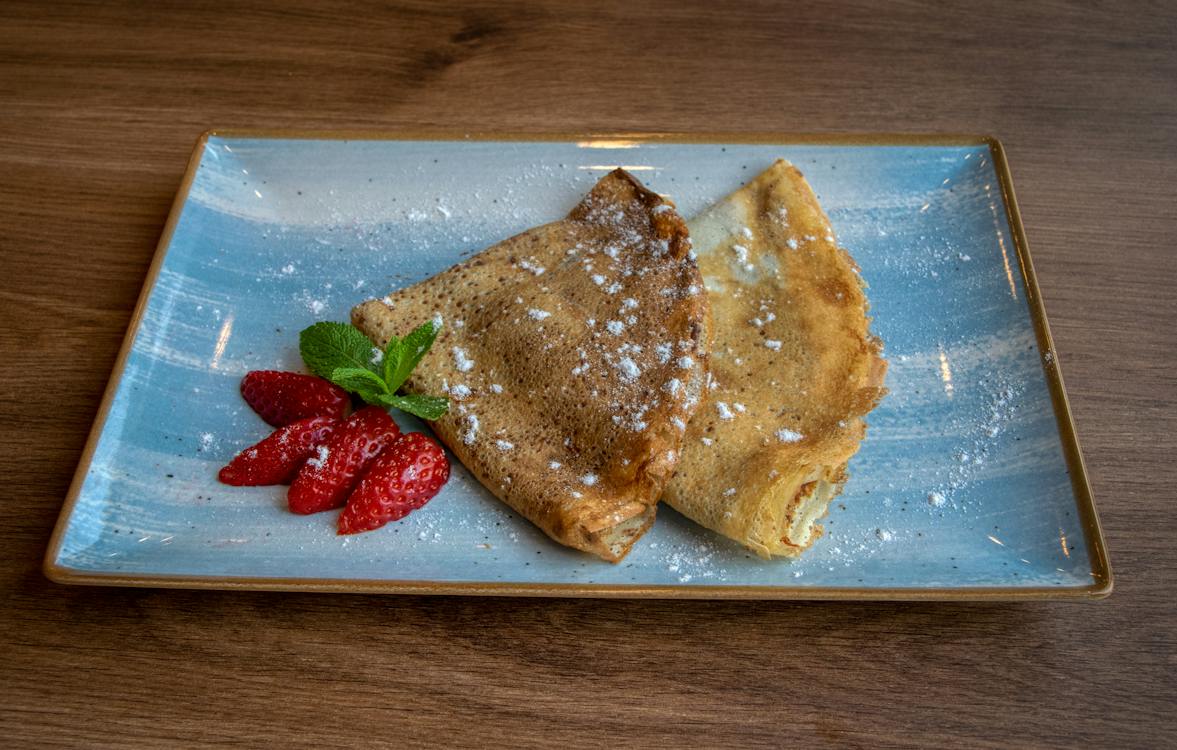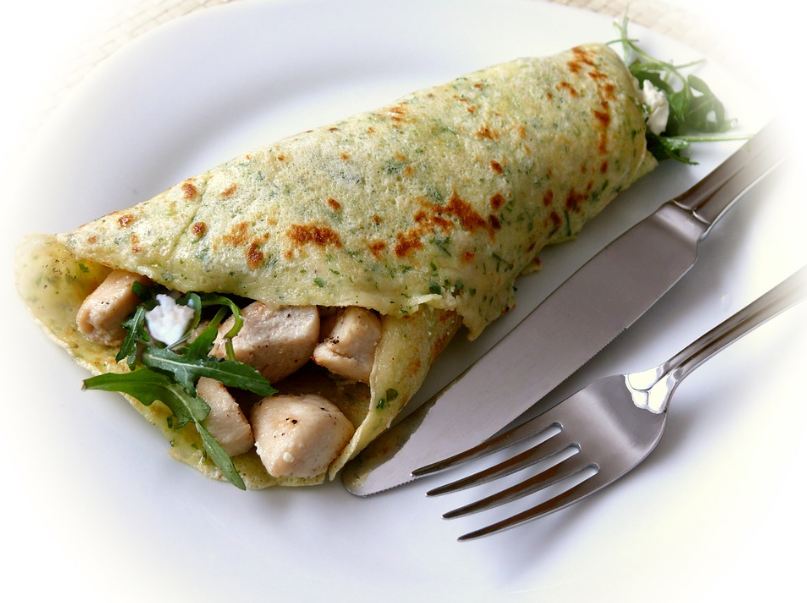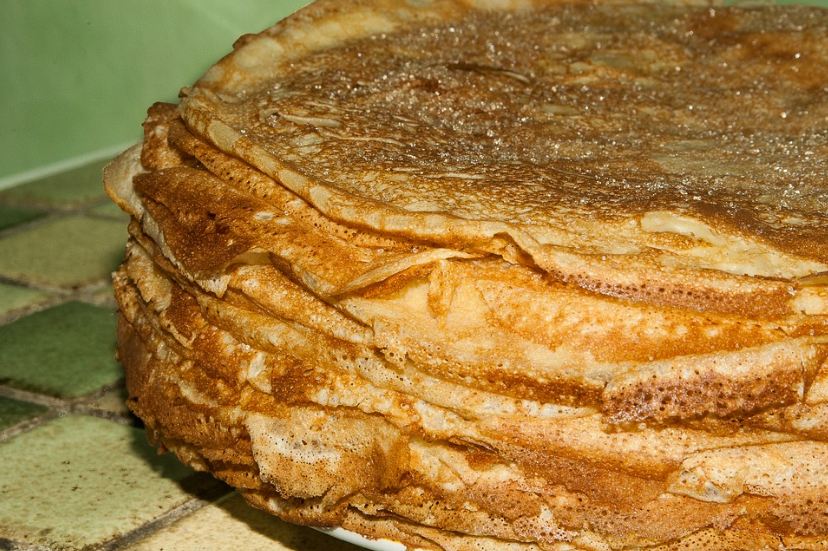Crêpes are thin pancakes made with wheat flour that originated in Brittany, France. Crêpes, although being a French staple and national delicacy, had become so popular that they had spread throughout the world since the 20th century when white wheat flour became more accessible. Milk, flour, butter, and eggs are whisked into a thin batter, then placed onto a crêpe pan and fried.
It’s customary to flip them in the air as they cook, and they said that catching it in the pan will ensure your family’s prosperity for the rest of the year. Crêpe comes from the Latin root “crispa,” which means “curdled.” Crêpes are a popular French dessert that can be filled with delicious fillings like berries, chocolate, jam, or whipped cream.
Savory foods like cheese, ham, eggs, sausages, mushrooms, or spinach can also be put into them. These delectable pancakes can be eaten hot or cold and found in crêperies all around France and far beyond.
History of Crêpes
Crêpes are a delicacy from France. They were created in Brittany in the thirteenth century, which was such a long time ago! Brittany, or Bretagne in French, is France’s westernmost region. This region is well-known for its wet weather, but it is best renowned for its crêpes.
After the Crusades brought buckwheat to France, crêpes were invented there. The flour obtained from this cereal was used to make a circular, thin crepe.
Crêpes come in a variety of shapes and sizes in Brittany. Buckwheat crêpes, known as “galettes,” are typically served with salty toppings. Wheat flour is used to make traditional crêpes, which are eaten with sweet toppings.
There is a day in France called “La Chandeleur” where everyone consumes crêpes. Forty days following Christmas, this day marks the Christian commemoration of Jesus’ introduction at the Temple. People used to eat crêpes on this day to finish the previous year’s wheat supply and bring good luck for the coming year’s harvest.
French Crêpes vs. American Pancakes
The most apparent distinction between fluffy pancakes from around the world and thin French crêpes is their thickness. The former uses a leavening/raising ingredient like baking powder, but the latter does not. Aside from that, pancakes are often served stacked on top of one another with a smidge of height.
Crêpes, on the other hand, are fancy. These paper-thin “cakes” are meant to cover the entire pan’s base. Typically, they are served folded or rolled with a choice of sweet and savory fillings.
Advantages and Disadvantages of Making Crêpes
Crêpes are easier to make than pancakes. They use fewer cooking tools and generate less mess than their fluffy counterpart because they are made with fewer ingredients. Crêpes have a more neutral flavor than pancakes, allowing them to be filled with both sweet and savory ingredients. And, the best part is, they won’t go bad if you make them ahead of time and store them in the fridge.
The disadvantage of crêpe-making is that it’s a skill that you must hone. It would be best to spread the batter thinly enough in the pan to make the perfect crêpes. To do so, you’ll need some practice and a lot of ruined crêpes at first.
How to Make French Crêpes
Choosing the Pan
When it comes to making crêpes, you have two pan options:
- Carbon steel crêpe pan – shallow and has finely tapered sides to make flipping easier. If you don’t make crêpes daily, though, this pan isn’t an advisable investment.
- Regular nonstick pan – is used for the standard pancake recipes. Use aluminum, copper, or a tri-ply clad pan to provide equal heating.
Ingredients
- 1 cup all-purpose flour
- 4 large eggs
- 1 tablespoon sugar
- 3 tablespoons unsalted melted butter or vegetable oil
- 1 1/2 cups whole milk
- 1/4 teaspoon salt
Only three components are used in simpler recipes of French crêpes: eggs, flour, and milk. If you want to stuff them with savory ingredients, leave out the sugar.
Instructions
- Whisk all the ingredients by hand in a large bowl until smooth and well combined, or blend them all in a blender for about 15 seconds until smooth and thoroughly incorporated.
- Allow at least 30 minutes for the crepe batter to rest. This step isn’t necessary, so if you’re in a hurry, you can skip it.
- In a preheated pan, rub a thin coating of vegetable oil or butter, then wipe away the excess with a paper towel.
- Pour the crepe batter from the blender into the center of the pan and swirl it around to coat the bottom evenly in a thin coating. Another way is to pour more batter than you need in the middle of the pan, swirl it around to form an even coat at the bottom, then tip the pan to eliminate excess batter by putting it back into the blender.
- After pouring the batter into the pan, heat it on high for a few minutes before lowering the temperature to medium. Cook for around 15 seconds, or until the top of the crepe has set and seems dry.
- Use a spatula only to loosen the crepe’s edges, then take it up with your fingers and turn it over slowly. Cook for another 15 seconds or until the opposite side is light brown.
- Stack the finished crêpes on a plate and serve right away, or store them in the refrigerator for a few days, covered in plastic wrap.



